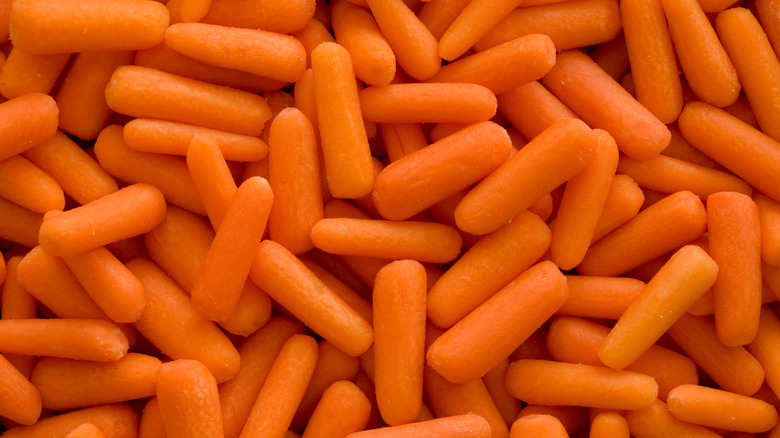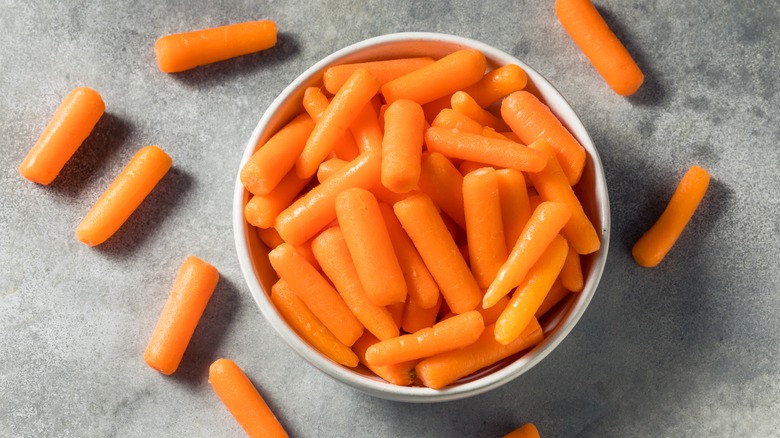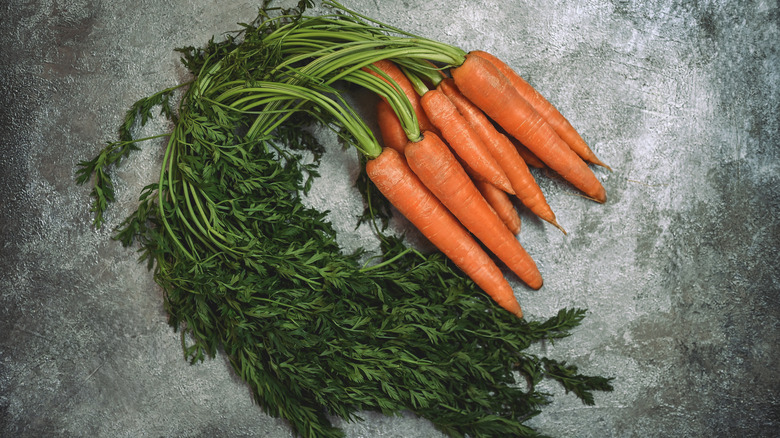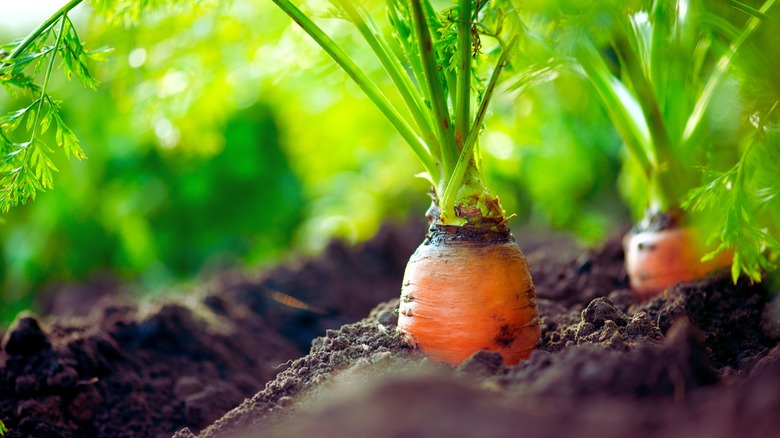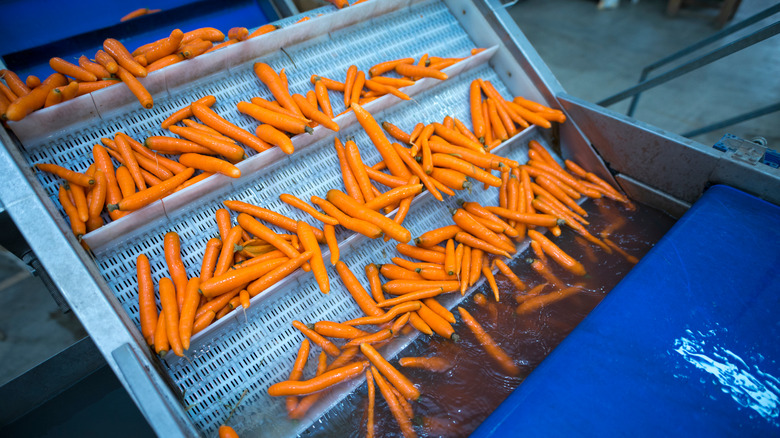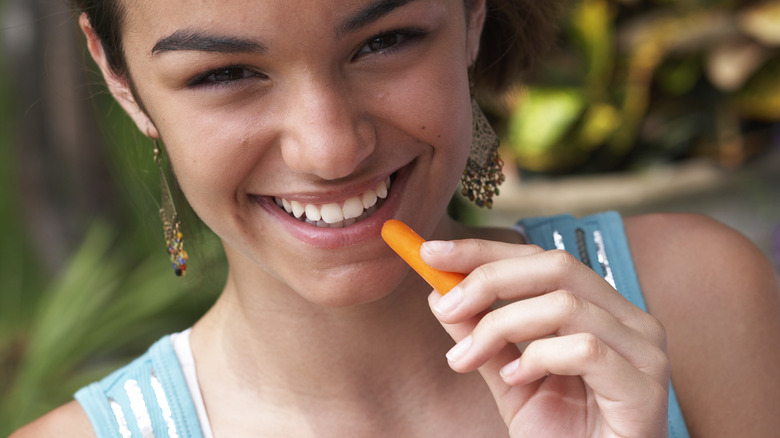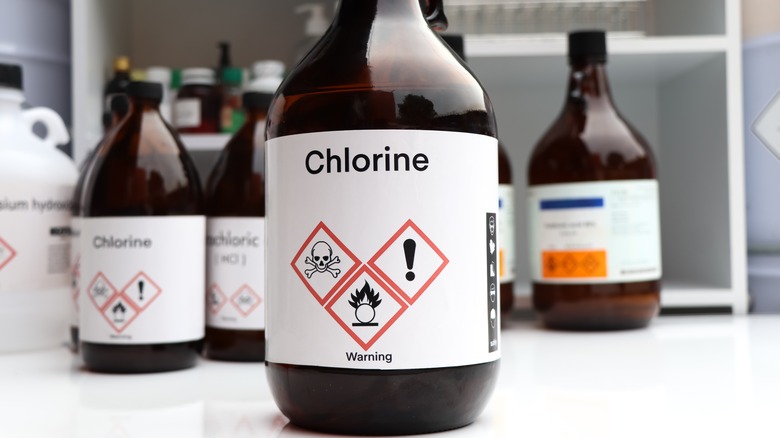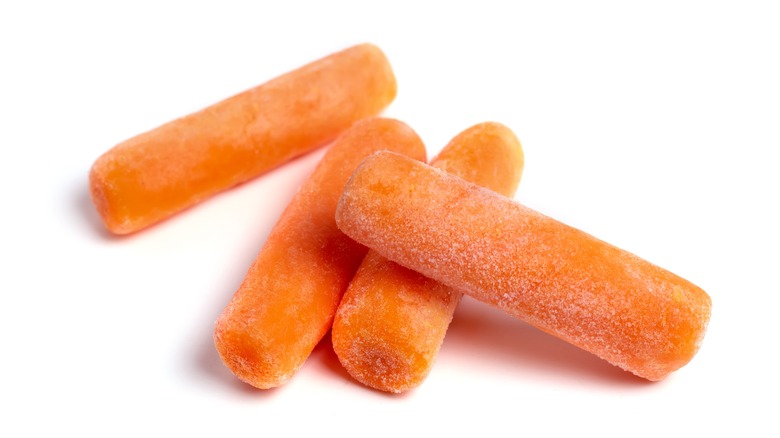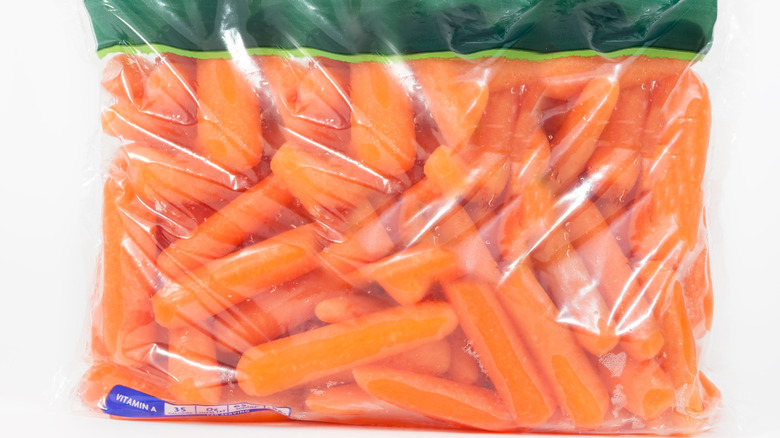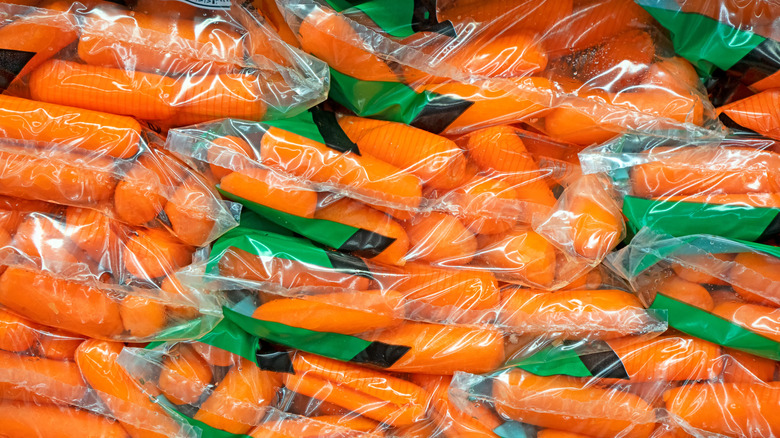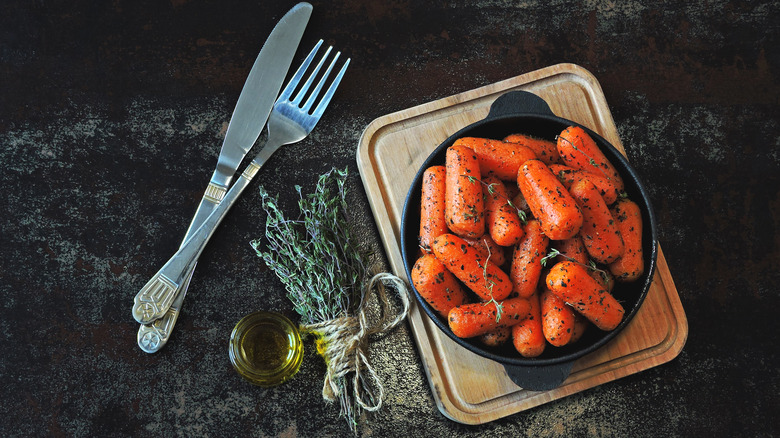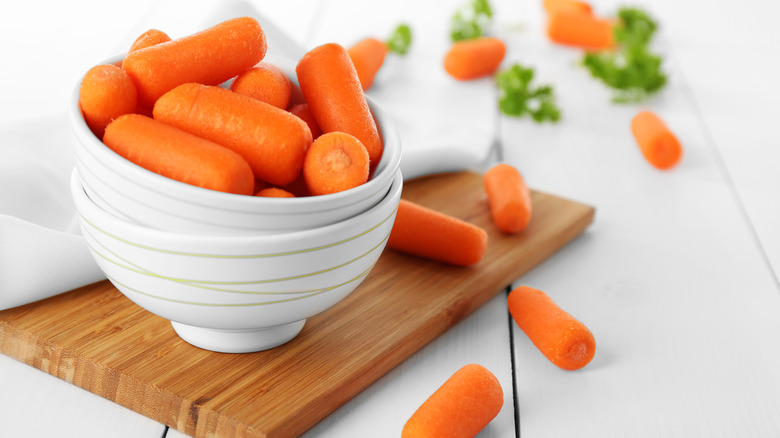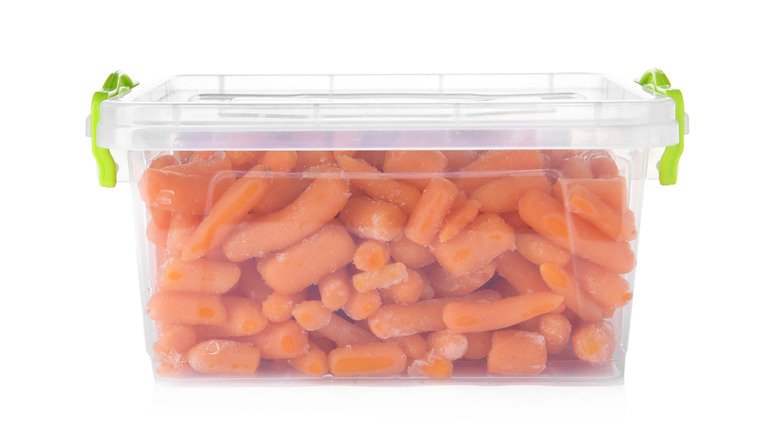What You Might Not Know About Baby Carrots
Baby carrots are the epitome of convenience when it comes to cooking or eating them raw. They come in a bag ready for quick, easy consumption, no washing required. However, baby carrots are surprisingly somewhat controversial. From potentially being soaked in chlorine to the formation of a white blush to their origin, there's a lot you probably don't know. Don't worry, though. All that and much more will be explained below. Once you have all the facts, you can decide whether or not baby carrots are worth the elevated price tag and simplicity of use based on your specific preferences and needs.
I scoured online news publications, chef forums, reputable nutrition sites, and more to create a comprehensive guide on baby carrots and unearth lesser-known facts. Keep reading to discover what you might not know about baby carrots and a whole lot more so you can make an informed choice the next time you contemplate picking up a bag from the grocery store.
What are baby carrots?
Undoubtedly, you've spotted baby carrots in the grocery store before. They come in small plastic bags full of small, trimmed carrots and are often stocked next to similarly sized bags of carrot chips and matchstick carrots. Some baby carrot bags also have a small amount of liquid in them. Whether you've bought them before or not, chances are good you can picture the product in your mind. Even so, baby carrots have distinct traits that classify them as such, and surprisingly, it doesn't have to do with the specific variety.
Unlike rainbow carrots, which come in varying colors, baby carrots are just plain old regular carrots that have been cut down to a smaller, more manageable size. While this may come as a shock to some of you, baby carrots aren't a particular type of carrot. Instead, they are simply typical orange carrots that have been diligently prepped and cut down to about two inches in length so that they are ready for use straight out of the bag without any additional effort on your part. As a result, they make cooking with carrots extremely simple.
Baby carrots vs regular carrots: What is the difference?
In general, baby carrots are still shaped much like regular carrots. They have a conical shape that is often narrower on one end and wider on the other. Both baby carrots and regular long carrots are also orange, so what's the difference between the two? In reality, not much. The main difference is their size. As you know, baby carrots are much smaller than their regular, longer counterparts. In addition, regular carrots come with the skins on, whereas baby carrots do not. Some regular carrots also come with leafy stalks on the end, but not always.
Another difference between baby and regular carrots is how they are packaged and sold. Baby carrots come in a bag with an abundance of pieces, and regular carrots can be bought individually. Full-size carrots can also be purchased in a bag with several inside, but they offer a bit more flexibility when it comes to choosing a specific quantity.
How did baby carrots first come about?
The initial idea for baby carrots was born out of a desire to minimize waste, which is something we can all get behind. According to CBS News, Mike Yurosek and his son Dave came up with the concept in 1985. Both California farmers, they enjoyed growing carrots but hated throwing away nearly half of their crop due to cosmetic imperfections. If a carrot was bent or broken, it was deemed waste, and they wanted to come up with a way to market and sell imperfect carrots. After all, they still taste the same. In addition to the issue of throwing away a considerable amount of their carrot crop, the time and effort required to peel and cut carrots was another factor they wished to remedy.
Brilliantly, Mike Yurosek and his son came up with the idea to repurpose a bean-cutting machine to carve misshapen carrots into smaller pieces that were the appropriate size for cooking. However, after conducting focus groups, Yurosek discovered that people actually want small carrots for snacking, not cooking. So, a few changes were made, including retrofitting an entire processing plant, and voila, baby carrots were born. In the early 1990s, they became available in stores, and when they did, the results were astonishing. Carrot consumption skyrocketed in the U.S., and today, it is estimated that 70% of total carrot sales are from baby carrots (via CBS News).
How are baby carrots made?
While there are probably a few things you don't know about carrots, how baby carrots are made is one of the most interesting. The process has developed quite a bit since the Yurosek family first repurposed a bean-cutting machine, but the concept remains the same. A machine still cuts regular-sized carrots into two-inch pieces, but the technology has come a long way. Business Insider talked with one of the companies that makes these carrot-cutting machines, Marcelissen, to get the low-down on the process from start to finish.
To start, full-grown carrots succumb to a process called plugging. Individual carrots are dropped into a machine that slices their tops off. Then, the carrots are cut into small, two-inch pieces by a series of blades. One carrot can be cut into anywhere from two to four baby carrots, depending on its initial length. Next, the newly sliced carrots fall into a machine that polishes them. It spins a batch of carrots around until the peels come off and the edges smooth out. Once sufficiently buffed, the result is small baby carrots with rounded edges and no skins, just like you buy from the store. Of course, they still need to be inspected and packaged, but they are fully formed.
Do baby carrots taste the same as whole carrots?
For the most part, baby carrots taste just like regular carrots. They are sweet and crunchy and, depending on the specific carrot, can sometimes be earthy and slightly bitter as well. Considering baby carrots and full-size carrots are the same thing, just differently sized and shaped, it's pretty obvious they will have a similar flavor. However, sometimes the difference is in the details, and baby carrots are fantastic examples of why.
Depending on the crop and the bag you pick up at the store, baby carrots can have a somewhat diminished taste that is less sweet and less flavorful overall. This is because it is not uncommon for baby carrots to be made with older carrots. When carrots are given a chance to age before consumption, their natural sugars start turning into starch. The result is a reduction in flavor and sweetness.
Don't get us wrong; baby carrots are regular carrots, so the flavor difference is pretty minimal. You can easily use baby carrots in any recipe that calls for carrots. Just remember, full-size carrots are often more dependable when it comes to getting the most potent flavor. Even so, you are unlikely to notice a difference when used in a recipe with a myriad of other ingredients and flavors unless you have a super refined palate.
Are baby carrots soaked in chlorine?
Maybe you've heard the rumor, maybe not, but word on the street is that baby carrots are soaked in chlorine. Some people even speculate that the white blush on some baby carrots is because they are treated with chlorine. While this sounds toxic and, well, just plain gross, there's a bit more to it than you may expect. First, the white blush on baby carrots is not chlorine seeping out from the interior. It's just a sign that they are losing their inherent moisture, but more on that later.
A spokesperson from the world's largest carrot company, Grimmway Farms, spoke with FoxNews.com about the use of chlorine in their baby carrots. They confirmed that before baby carrots are packaged and sold, they undergo a thorough scrubbing paired with a chlorine rinse. Surprisingly, this includes their organic products. However, this appears to be considered standard practice for produce that comes pre-cut, including but not limited to bags of lettuce. Without the final chlorine rinse, the risk of foodborne illnesses like E. coli cannot be effectively addressed. The Grimmway spokesperson also states that the amount of chlorine used in the rinse is similar to that of tap water and is most certainly within EPA limits.
So, now that you know the facts, it is up to you to decide whether the chlorine is a deal-breaker for you and your home or not. Either way, baby carrots are indeed safe to consume.
Why do baby carrots develop a white blush on the exterior?
Have you ever gone to get a bag of baby carrots out of the fridge and noticed that they have a white blush forming on the exterior? If so, you probably wondered if the discoloration meant they were turning bad or if they were still safe for use, and rightfully so. Typically, when vegetables, fruits, and other foods start to lose their color, it is a signal that they aren't good anymore. However, with baby carrots, this isn't always the case. For the most part, they are still perfectly fine for consumption after a white blush shows up. Of course, if you let them sit like this for a few weeks, it may be a different story, but white blush isn't a direct indicator that baby carrots need to be tossed in the garbage.
The white blush on baby carrots is just a sign of them losing their moisture. While this may result in a slight loss of flavor, you can feel free to keep munching on them. Due to their polished and cut-down form, baby carrots dry out faster than whole carrots, particularly if you don't store them in an airtight container. When this happens, you can revive the color in a couple of minutes. Simply soak them in a bath of cool to ice-cold water and watch as the color returns. If you're lucky, you may even notice a slight increase in flavor, too.
Why do baby carrots sometimes become slimy?
Aside from white blush, another common issue people encounter with baby carrots is that they easily develop a slimy film on the outside. The slimy film can be off-putting, but again, it is not a surefire sign that they have spoiled. Often, the sliminess is caused by the extra liquid that comes in a bag of baby carrots. While it is supposed to prevent the processed baby carrots from drying out, which happens faster than with whole carrots, it can lead to a slimy feel if not eaten quickly enough.
There are a couple of easy fixes to avoid the dreaded slimy feeling. First, make sure you devour your bag of baby carrots quickly. This ensures they don't have a chance to change much. This isn't always possible, but it is a guaranteed way to avoid discoloration or a change in texture. Second, drain the water from the bag before it gets a chance to seep into your baby carrots. Sure, this may lead to them drying out more quickly, but that is typically better than the alternative. You can always put them in another, more airtight bag or container to slow down the drying process.
Where to buy baby carrots
Baby carrots are loved and consumed at a considerable rate, at least in the United States. Due to their widespread popularity, they can easily be purchased in virtually any grocery store. Even smaller markets tend to carry them. They are generally kept in the refrigerated part of the produce section next to other bagged carrots like shredded carrots and carrot chips. If you can't seem to find them, chances are they are just sold out at the moment.
Thanks to their prevalence, baby carrots can also be ordered through online vendors. From Amazon to Target to other major produce suppliers, you shouldn't have any problems finding them. Plus, many places offer free or same-day shipping, so you shouldn't have to wait very long for them to arrive at your door. When it comes to convenience, online shopping is practically unbeatable, even when it comes to buying groceries.
Purchase baby carrots on AmazonFresh for $1.29.
Purchase baby carrots online through Walmart for $1.38.
Purchase organic baby carrots on Good Eggs for $2.99.
Do baby carrots cost more?
Bags of baby carrots are pretty inexpensive overall. Depending on where you buy them, they generally only cost about $1.50 to $2.00 for a smaller bag. Organic options will run you slightly more, but that is to be expected. While this seems relatively cheap, the price is actually quite steep compared to regular carrots.
We know carrots are fairly inexpensive overall, but the additional cost can add up quickly over time. If you are looking for the cheapest option, baby carrots aren't the answer. They are exceptionally convenient to eat and use since they come pre-peeled and cut into a snackable size, but you have to pay for this convenience through an increased price. For many people, the higher cost pays for itself when it comes to effort and speedy use, but peeling and cutting carrots isn't really difficult. Prepping carrots doesn't take long, either. So, you'll have to decide for yourself if the higher price is worth the convenience or not.
How to cook with baby carrots
Baby carrots come in the perfect size for snacking. As such, many people eat them raw, but that doesn't mean they can't be cooked. In fact, they can be used in any recipe that calls for carrots. In many cases, they will only make things easier because they are already peeled and cut. Baby carrots can be roasted, steamed, sauteed, fried, air-fried, or grilled. You can cook them just as they are or cut them into smaller, more uniform thicknesses and sizes. Either way, they are simple, quick, and convenient to cook.
Roasting baby carrots is one of the easiest and best ways to prepare them. It doesn't require any additional dicing. All you need to do is toss them in oil, apply seasonings, and bake for approximately 30 to 45 minutes. You can obviously add other seasonings, like rosemary, chili flakes, thyme, parsley, and more, but they taste delicious with just a sprinkle of salt and pepper, too. You can also add a sweetener like maple syrup, brown sugar, or honey for tasty glazed carrots.
Nutritional information
Baby carrots are pre-peeled, and according to the National Nutrition Council, some of their nutrition is found in the skin. As a result, they are slightly less nutritious than regular carrots. However, many people eat carrots without peels anyway, so you can expect to get just as much nutrition from baby carrots as you would from full-size carrots. Whatever form you consume, carrots are rich in important vitamins, minerals, antioxidants, and fiber. They are an outstanding source of Vitamins A, B6, and K1. Plus, they offer a hearty punch of potassium and biotin. All the vitamins and minerals combined provide you with an array of health benefits, so it isn't much of a surprise that baby carrots are thought of as a super nutritious snack.
Medical News Today reports that carrots are beneficial for healing wounds, bone health, maintaining a healthy digestive system, and improving immune functioning. They are also credited with reducing the risk of various types of cancer, supporting eye and vision health, and aiding in diabetes control and prevention. The abundance of potassium in carrots is also credited with reducing your risk for cardiovascular issues like high blood pressure and more.
How to store baby carrots
There are several recommended ways to store baby carrots to preserve freshness and ensure longevity after opening the bag. The method you choose will ultimately be determined by your preference for texture and how fast you anticipate eating them, but as long as you don't keep them in the opened bag you buy them in, you will be doing yourself a big favor. The first and probably most common way to store baby carrots is in the fridge in an airtight container. Whether you choose a resealable bag or a plastic or glass dish with a tight lid, an airtight seal locks moisture in and prevents them from drying out or spoiling too quickly for you to enjoy them. Many people also give baby carrots a quick rinse before transferring them to another container.
The second way to keep your carrots fresh for as long as possible is to add a moist paper towel to the bottom of your airtight container. If you go this route, you are unlikely to see a white blush form, but it can make the carrots lose some of their crunch. The third method for storing baby carrots involves submerging them in a water bath in an airtight container. While this guarantees they won't dry out, it can make them slimy if they are not eaten quickly. If you choose this option, you'll also want to change out the water every couple of days.

